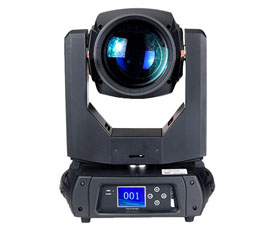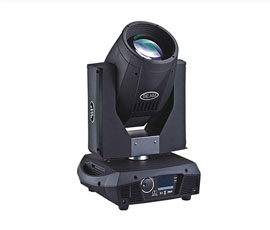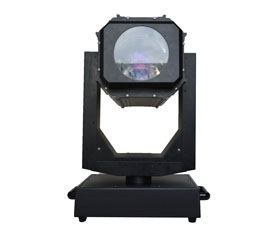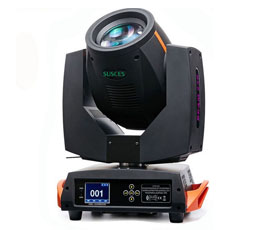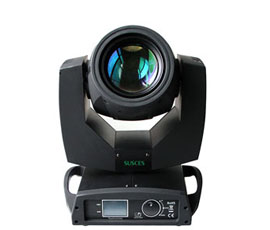
What are the technical effects of stage lighting?
Date:2017/10/7
source:sichengstagelight
Since the stage has been produced, stage lighting has become part of the stage. Stage lighting, expensive in highlighting the four elements of vision, realism, aesthetics and performance. Has experienced many years of evolution. Gradually developed into todays more complete and advanced lighting system. The first prosperous period of drama, appeared in ancient Greece more than two thousand years ago. At that time the theater was open or half open. The stage of the lighting rely on heaven that huge "light" - the sun, so only in the daytime performance. And the need for night entertainment, outdoor performances vulnerable to weather and other objective defects and the development of drama so that the stage lighting has become a problem people must solve.
Whether the performance of the lighting design is successful, is the stage lighting is handled properly as a sign. Stage lighting not only to illuminate the actors, so that the audience to see facial expressions, demeanor and action, more importantly, the full use of lighting technology, mobilize lighting operations and other means to strengthen the artistic effect, so that the audience has immersive.
Stage lighting is mainly produced by the combination of computer lights and other lighting effects, through different modeling scenes, different color changes, different viewing angles, horizontal, vertical light angle changes and speed, strobe speed, aperture size changes , Focal length changes and other comprehensive performance. Then, in understanding the stage lighting technology must master these basic knowledge before:
One, visible light
Light is radiated in the form of electromagnetic waves. Electromagnetic radiation wavelength range is very wide, only the wavelength of 380 ~ 760nm this part of the radiation can cause light vision, known as visible light. Light is shorter than 380nm light is ultraviolet, x-ray, γ-ray; longer than 760nm light is infrared, radio waves, etc., they can not produce light on the human eye, that is invisible. Therefore, light is an objective energy, and with the subjective feeling of people are closely linked.
Second, the classification of color
Color can be divided into two categories of non-color and color. Achromatic refers to the white, light gray, gray to dark gray, until black, called white and black series. Pure white is the ideal object of complete light reflection, the reflectivity of 1; pure black is the ideal non-reflective objects, the reflectivity of 0. Therefore, the non-color white series represents the objects light reflectivity changes. We know that the light reflectivity is proportional to the brightness, indoor white walls and ceiling can get a higher brightness. Color refers to a variety of colors other than black and white series. Color has three characteristics: tone, brightness and saturation, known as the three elements of color.
The hue is the color that is presented. That is, a variety of different colors of the name, such as red, green, blue and so on. It is related to the wavelength of light. Brightness (brightness) is the brightness of the color. Different tone of the brightness is different, even if the same tone due to the nature of the surface of the object and the intensity of light will produce different shades, shades of the difference. Such as the same is yellow, you can have light yellow, yellow, dark yellow and so on.
Saturation (saturation) that the color of the depth (shades), it can be said that the color purity, bright degree. The higher the saturation, the deeper the color (thick), the visible light in a variety of monochromatic light is the most saturated color. When the spectrum of color mixed with the more white, the more unsaturated. For example, the red light is higher than the saturation of the pink light, because the pink light is incorporated into the white light. In general, the same tone, the brightness changes, the saturation also changes, but the brightness of the increase or decrease its saturation are reduced, only moderate brightness when the saturation (purity) is the largest. But the feeling of giving, always feel always bright and bright colors look more bright.
Three, three primary colors and color method
Red, green, blue is called three primary colors. These three colors are mixed in different proportions to produce various colors. There are two basic methods of color mixing: color mixing and subtractive blending.
The so-called color mixing method is when the different colors of light mixed, they put their own part of the spectrum together, resulting in a new method of mixed color. Indicating the fineness relationship between light and color mixing. Red, green, blue three primary colors of light mixed when available:
Red + green = yellow green + blue = green light
Green + red = magenta red + green + blue = white
If not equal to the three primary colors of light mixed, you can get a variety of intermediate colors, such as:
Red more + green light = orange light
Red light more + blue light = pink light
The subtractive method is a mixture of different colors, each of which chooseively absorbs the corresponding portions of the incident light from the incident light, and produces a synthetic color effect. Any two kinds of shade after the addition of white light, the two shades of complementary color (complementary color). Such as yellow and blue complement each other, green and red complement each other, magenta and green complement each other. Therefore, the yellow, blue, magenta, respectively, known as the reduction of blue, red, minus the green, that is, three complementary colors are reduced by a white light from the corresponding primary colors. So yellow, blue, magenta can be called subtractive three primary colors.
When the yellow, magenta, green three subtractive colors overlap together will produce black. In the subtractive process, the density of the three subtractive primary colors controls the absorption ratio of red, green and blue, respectively, so as to obtain various mixed colors, which can achieve the same effect as the additive method.
Four, color and vision
Color will give people a sense of cold and warm, sense of distance, size and sense of severity, and often make people associate, resulting in different psychological effects, these are people long-term formation of visual habits.
Colors can usually be divided into three categories: cool, warm and neutral (middle). The color of the cold and warm is based on a variety of colors caused by the visual response and psychological association division. Red makes people think of the heat of the fire, resulting in a warm feeling, called warm. Blue people think of cold water, giving a sense of cold, so called cool. Purple, green is not cold nor cool color neutral color. Different colors can affect the size of the appearance of the object. If you put some of the same size of the same size objects together, in the visual sense will produce light white objects. Dark black objects are small. In general, white objects look the most, black objects look the smallest, yellow objects larger, followed by green, red, blue.
People on the color of the visual habits will have a sense of distance. Different colors of the object at the same distance gives a different visual experience. Warm color gives the feeling of moving forward, cool color is far away from the feeling. And the color gives the sense of distance is also affected by the background color. For example, when the white background, the blue looks look closer; with black as the background, the red looks most recent, followed by orange, yellow, green, blue, purple. The use of this feature can help us to create a color three-dimensional, sense of distance from the illusion effect.
The color of the heavy sense of people is the long-term formation of the visual habits. Generally believed that the white lightest, black the most important. In the three primary colors of light, the green lightest, blue the most heavy, red center. There are two kinds of primary colors mixed with the formation of color, with light color appears light, with heavy color appears heavy. The weight of the color is not only expressed by brightness and purity, but also by the color in the screen to occupy the size of the impact. Large area of the larger and smaller than the area of the color can attract more peoples attention.
Whether the performance of the lighting design is successful, is the stage lighting is handled properly as a sign. Stage lighting not only to illuminate the actors, so that the audience to see facial expressions, demeanor and action, more importantly, the full use of lighting technology, mobilize lighting operations and other means to strengthen the artistic effect, so that the audience has immersive.
Stage lighting is mainly produced by the combination of computer lights and other lighting effects, through different modeling scenes, different color changes, different viewing angles, horizontal, vertical light angle changes and speed, strobe speed, aperture size changes , Focal length changes and other comprehensive performance. Then, in understanding the stage lighting technology must master these basic knowledge before:
One, visible light
Light is radiated in the form of electromagnetic waves. Electromagnetic radiation wavelength range is very wide, only the wavelength of 380 ~ 760nm this part of the radiation can cause light vision, known as visible light. Light is shorter than 380nm light is ultraviolet, x-ray, γ-ray; longer than 760nm light is infrared, radio waves, etc., they can not produce light on the human eye, that is invisible. Therefore, light is an objective energy, and with the subjective feeling of people are closely linked.
Second, the classification of color
Color can be divided into two categories of non-color and color. Achromatic refers to the white, light gray, gray to dark gray, until black, called white and black series. Pure white is the ideal object of complete light reflection, the reflectivity of 1; pure black is the ideal non-reflective objects, the reflectivity of 0. Therefore, the non-color white series represents the objects light reflectivity changes. We know that the light reflectivity is proportional to the brightness, indoor white walls and ceiling can get a higher brightness. Color refers to a variety of colors other than black and white series. Color has three characteristics: tone, brightness and saturation, known as the three elements of color.
The hue is the color that is presented. That is, a variety of different colors of the name, such as red, green, blue and so on. It is related to the wavelength of light. Brightness (brightness) is the brightness of the color. Different tone of the brightness is different, even if the same tone due to the nature of the surface of the object and the intensity of light will produce different shades, shades of the difference. Such as the same is yellow, you can have light yellow, yellow, dark yellow and so on.
Saturation (saturation) that the color of the depth (shades), it can be said that the color purity, bright degree. The higher the saturation, the deeper the color (thick), the visible light in a variety of monochromatic light is the most saturated color. When the spectrum of color mixed with the more white, the more unsaturated. For example, the red light is higher than the saturation of the pink light, because the pink light is incorporated into the white light. In general, the same tone, the brightness changes, the saturation also changes, but the brightness of the increase or decrease its saturation are reduced, only moderate brightness when the saturation (purity) is the largest. But the feeling of giving, always feel always bright and bright colors look more bright.
Three, three primary colors and color method
Red, green, blue is called three primary colors. These three colors are mixed in different proportions to produce various colors. There are two basic methods of color mixing: color mixing and subtractive blending.
The so-called color mixing method is when the different colors of light mixed, they put their own part of the spectrum together, resulting in a new method of mixed color. Indicating the fineness relationship between light and color mixing. Red, green, blue three primary colors of light mixed when available:
Red + green = yellow green + blue = green light
Green + red = magenta red + green + blue = white
If not equal to the three primary colors of light mixed, you can get a variety of intermediate colors, such as:
Red more + green light = orange light
Red light more + blue light = pink light
The subtractive method is a mixture of different colors, each of which chooseively absorbs the corresponding portions of the incident light from the incident light, and produces a synthetic color effect. Any two kinds of shade after the addition of white light, the two shades of complementary color (complementary color). Such as yellow and blue complement each other, green and red complement each other, magenta and green complement each other. Therefore, the yellow, blue, magenta, respectively, known as the reduction of blue, red, minus the green, that is, three complementary colors are reduced by a white light from the corresponding primary colors. So yellow, blue, magenta can be called subtractive three primary colors.
When the yellow, magenta, green three subtractive colors overlap together will produce black. In the subtractive process, the density of the three subtractive primary colors controls the absorption ratio of red, green and blue, respectively, so as to obtain various mixed colors, which can achieve the same effect as the additive method.
Four, color and vision
Color will give people a sense of cold and warm, sense of distance, size and sense of severity, and often make people associate, resulting in different psychological effects, these are people long-term formation of visual habits.
Colors can usually be divided into three categories: cool, warm and neutral (middle). The color of the cold and warm is based on a variety of colors caused by the visual response and psychological association division. Red makes people think of the heat of the fire, resulting in a warm feeling, called warm. Blue people think of cold water, giving a sense of cold, so called cool. Purple, green is not cold nor cool color neutral color. Different colors can affect the size of the appearance of the object. If you put some of the same size of the same size objects together, in the visual sense will produce light white objects. Dark black objects are small. In general, white objects look the most, black objects look the smallest, yellow objects larger, followed by green, red, blue.
People on the color of the visual habits will have a sense of distance. Different colors of the object at the same distance gives a different visual experience. Warm color gives the feeling of moving forward, cool color is far away from the feeling. And the color gives the sense of distance is also affected by the background color. For example, when the white background, the blue looks look closer; with black as the background, the red looks most recent, followed by orange, yellow, green, blue, purple. The use of this feature can help us to create a color three-dimensional, sense of distance from the illusion effect.
The color of the heavy sense of people is the long-term formation of the visual habits. Generally believed that the white lightest, black the most important. In the three primary colors of light, the green lightest, blue the most heavy, red center. There are two kinds of primary colors mixed with the formation of color, with light color appears light, with heavy color appears heavy. The weight of the color is not only expressed by brightness and purity, but also by the color in the screen to occupy the size of the impact. Large area of the larger and smaller than the area of the color can attract more peoples attention.
Previous: How can check LED ParLight Broke
Previous: How to design bar lights
Related articles TAG:stage lighting
